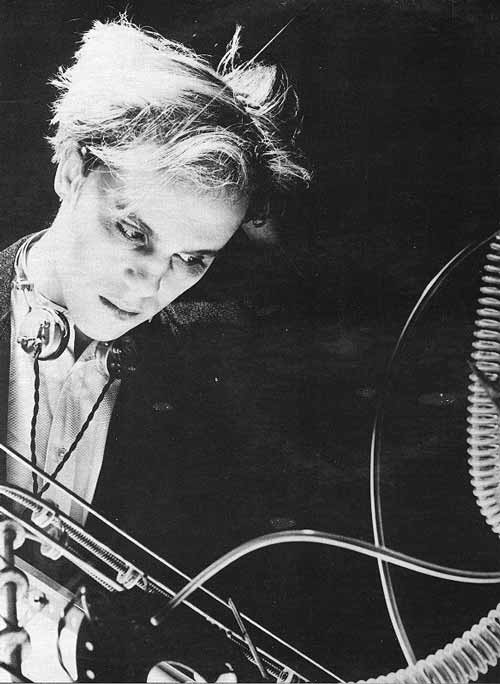| 
Thomas Dolby
Though
he never had many hits, Thomas Dolby became one of the most
recognizable figures of the synth-pop movement of early-'80s
new wave. Largely, this was due to his skillful marketing.
Dolby promoted himself as a kind of mad scientist, an egghead
that had successfully harnassed the power of synthesizers
and samplers, using them to make catchy pop and light electro-funk.
Before he launched a solo career, Dolby had worked as a studio
musician, technician, and songwriter; his most notable work
as a songwriter was "New Toy," which he wrote for
Lene Lovich, and Whodini's "Magic's Wand." In 1981,
he launched a solo career, which resulted in a number of minor
hits and two big hits -- "She Blinded Me with Science"
(1982) and "Hyperactive" (1984). Following "Hyperactive,"
his career faded away, as he began producing more frequently,
as well as exploring new synthesizer and computer technology.
Dolby continued to record into the '90s, but by that time,
he was strictly a cult act.
Dolby's interest in music arose through his interest in computers,
electronics and synthesizers. The son of a British archeologist,
Thomas Dolby (b. Thomas Morgan Robertson, October 14, 1958)
originally attended college to study meteorology, but he was
soon side-tracked by electronics, specifically musical equipment.
He began building his own synthesizers when he was 18 years
old. Around the same time, he began to learn how to play guitar
and piano, as well as how to program computers. Eventually,
his schoolmates gave him the nickname of "Dolby,"
which was the name for a noise-reduction technology for audiotapes;
he would eventually take the nickname as a stage name.
In his late teens, Dolby was hired as a touring sound engineer
for a variety of post-punk bands, including the Fall, the
Passions and the Members; on these dates, he would use a PA
system he had built himself. In 1979, he formed the arty post-punk
band Camera Club with Bruce Woolley, Trevor Horn, Geoff Downes
and Matthew Seligman. Within a year, he had left the group
and joined Lene Lovich's backing band. Dolby gave Lovich his
song "New Toy," which became a British hit in 1981.
That same year, he released his first solo single, "Urges,"
on the English independent label Armageddon. By the fall,
he had signed with Parlophone and released "Europa and
the Pirate Twins," which nearly cracked the UK Top 40.
Dolby started playing synthesizer on sessions for other artists
in 1982. That year, he appeared on Foreigner's 4, Def Leppard's
Pyromania and Joan Armatrading's Walk Under Ladders. Also
in 1982, he wrote and produced "Magic's Wand" for
Whodini; the single became one of the first million-selling
rap singles. Even with all of these achievements, 1982 was
most noteworthy for the release of Dolby's first solo album,
The Golden Age of Wireless, in the summer of 1982; the record
reached number 13 in England, while it was virtually forgotten
in America. "Windpower," the first single from the
record, became his first Top 40 UK hit in the late summer.
In January of 1983, Dolby released an EP, Blinded by Science,
which included a catchy number called "She Blinded Me
with Science" that featured a cameo vocal appearance
by the notorious British eccentric Magnus Pike, who also appeared
in the song's promotional video. Blinded by Science was a
minor hit in England, but the EP and the single became major
American hit in 1983, thanks to MTV's heavy airplay of the
"She Blinded Me with Science" video. Eventually,
the song reached number five on the US charts and it was included
on a resequenced and reissued version of The Golden Age of
Wireless, which peaked at number 13 in America.
The Flat Earth, Dolby's second album, appeared in early 1984
and was supported by the single "Hyperactive." The
single became his biggest UK hit, peaking at number 17. Though
The Flat Earth reached number 35 on the US charts, Dolby's
momentum was already beginning to slow -- none of the singles
released from the album cracked the American Top 40. Nevertheless,
Dolby was in demand as a collaborator and he worked with Herbie
Hancock, Howard Jones, Stevie Wonder, George Clinton, and
Dusty Springfield. During 1985, he produced Clinton's Some
of My Best Jokes Are Friends, Prefab Sprout's Steve McQueen
(Two Wheels Good in the US), and Joni Mitchell's Dog Eat Dog,
as well as supporting David Bowie at Live Aid. Also in 1985,
he began composing film scores, starting with Fever Pitch.
In 1986, he composed the scores for Gothic and Howard the
Duck, to which he credited himself as Dolby's Cube. That credit
led to a lawsuit from the Dolby Labs, who eventually prohibited
the musician from using the name "Dolby" in conjunction
with any other name than "Thomas."
Aliens Ate My Buick, Dolby's long-delayed third album, appeared
in 1988 to poor reviews and weak sales, even though the single
"Airhead" became a minor British hit. That same
year, Dolby married actress Kathleen Beller. For the rest
of the late '80s and early '90s, Dolby continued to score
films, producing and he began building his own computer equipment.
His fourth album, Astronauts & Heretics, was released
in 1992 on his new label, Giant. Despite the presence of guest
stars like Eddie Van Halen, Jerry Garcia, Bob Weir and Ofra
Haza, the album was a flop. The following year, Dolby founded
the computer software company Headspace, which released The
Virtual String Quartet as its first program. For the rest
of the '90s, Headspace occupied most of Dolby's time and energy.
In 1994, he released The Gate to the Mind's Eye, a soundtrack
to the videotape Mind's Eye. Also that year, Capitol released
the greatest-hits collection, Retrospectacle.--Bio
Courtesy of allmusic.com
Vist
the official Thomas Dolby web site www.thomasdolby.com |